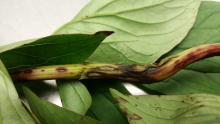Cause The fungi Gloeosporium sp. has been found in Oregon and Colletotrichum sp. was found in Washington. These pathogens generally overwinter in leaf litter; therefore, infested debris can serve as an important source of initial inoculum. Prolonged periods of leaf wetness can also favor disease development.
Symptoms Lesions and cankers on all aboveground parts of the peony. On stems, cankers are elongate and gray in color and often cause severe twisting or curling of the stem. Pink-colored fruiting structures (acervulus) can sometimes be observed in the cankers. Foliar leaf spots and infections of flowers and flower buds are, similarly, gray in color and can cause irregular growth of plant tissues or interfere with flower development.
Cultural control
- Increase air movement by wide plant spacing to avoid overcrowding of plants.
- Avoid overhead irrigation that keeps plants wet for extended periods of time.
- Remove all infected plant parts during the growing season.
- Cut and removed or destroy all plants at the end of the year to reduce overwintering inoculum.
Chemical control Information is not available regarding the effectiveness of fungicides for control of this disease on peonies. The following are registered on Peony and may be helpful when used in the spring prior to wet weather.
- CuPRO 5000 at 1.5 to 2 lb/A. Group M1 fungicide. 48-hr reentry.
- Mancozeb-based products can be used to provide some protection. Group M3 fungicides. 24-hr reentry.
- Fore 80 WP at 1.5 lb/100 gal water plus a spreader-sticker.
- Protect DF at 1 to 2 lb/100 gal water plus 2 to 4 oz spreader-sticker.
- Monterey Liqui-Cop at 3 Tbsp/gal water. H
- Nu-Cop 50 DF at 1 lb/100 gal water. Group M1 fungicide. 48-hr reentry.
- Ortho Rose & Flower Disease Control at 2 fl oz/gal water. Group 3 fungicide. H
- According to one IR-4 trial Pageant was safe on peony but had elevated residues. It may be useful for this disease at 6 to 12 oz/100 gal water. Do not use with organosilicone-based adjuvants. Group 7 + 11 fungicide. 12-hr reentry.
References Horst, R.K. 2013. Westcott's Plant Disease Handbook, 8th ed. Netherlands: Springer Science+Business Media.
Garfinkel, A.R., and Chastagner, G.A. 2018. Diseases of Peonies. In McGovern, R.J. and Elmer, W.H. (eds.) Handbook of Florists' Crops Diseases. Springer Int.


